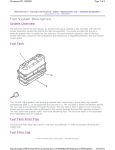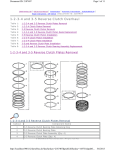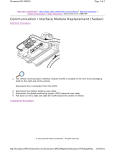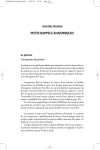Download Theft Systems Description and Operation
Transcript
Document ID: 1367203 2006 Pontiac GTO Page 1 of 7 | GTO (VIN V) Service Manual | Accessories | Theft Deterrent | Description and Operation | Document ID: 1367203 Theft Systems Description and Operation Theft Deterrent System The theft deterrent system uses a remote coded key to arm and disarm the system. The remote coded key is also used to electrically lock or unlock the doors and the trunk lock. System Operation When the ignition is turned ON, the body control module (BCM) sends the powertrain interface module (PIM) an encrypted BCM key security code. The security code is received via the slip ring or, in the event of no slip ring communication, by remote receiver. The PIM compares the received security code with the engine control module (ECM) stored security code and if the codes match, the PIM allows engine cranking and sends a separate encrypted security code to the ECM. The ECM compares this code with its stored security code and if the codes match, the ECM allows injector fuelling to continue. The PIM returns an OK TO START message, which triggers the BCM to jump from SHORT LOOP mode to the LONG LOOP mode. Armed The theft deterrent system can be armed actively, by pressing the lock button on the remote coded key or passively, when the BCM automatically arms the system 30 seconds after the ignition is turned OFF. When the theft deterrent system is armed, the following components are disabled and prevent the engine from being started: • The start relay, located in the engine compartment relay housing • The ECM © 2013 General Motors Corporation. All rights reserved. http://localhost:9001/si/showDoc.do?docSyskey=1367203&pubCellSyskey=59400&pubO... 5/16/2013 Document ID: 1367203 Page 2 of 7 • The PIM Disarmed The theft deterrent system can be disarmed by pressing the unlock button on the remote coded key, which will unlock the doors, turn the interior dome lamp ON and disarm the system for 30 seconds or by inserting the remote coded key into the ignition switch and turning the ignition ON. With the system disarmed and the ECM and PIM enabled, the engine can be started. The BCM then reads a security code from the remote coded key contact pin via the remote coded key reader assembly. This system allows up to 1 second of cranking time if the code is invalid. This usually results in the engine starting, but then dying after 2-3 seconds. Normally this allows for fuel priming and reduces start delays while the security message is being validated. Engine crank is then disabled until the next ignition cycle. If the engine cranks briefly when the ignition switch is turned to the start position, there may be a faulty remote coded key reader. Press the unlock button on the remote coded key to disarm the theft deterrent system. Remote Coded Key The theft deterrent system uses a remote coded key to arm and disarm the system and electrically lock or unlock the doors and the trunk lock. The RF transmitted by the remote coded key is received by the body control module (BCM) remote receiver located in the instrument panel between the demist ducts. After pressing the remote coded key lock button to arm the theft deterrent system, the indicators flash once and the security status telltale LED begins to flash. After disarming the system by pressing the key unlock button, the indicators flash twice and the security status telltale LED stops flashing. Important: Passive arming of the system does not automatically operate the door locks or flash the indicators. Battery The remote coded key is powered by its own internal battery. If this battery fails, the remote coded key reader can power the key when it is inserted into the ignition switch and turned ON or to the start position. Security Status Telltale The security status telltale LED, located in the instrument cluster assembly, indicates the state of the system. When flashing, the LED indicates that the system is armed and the vehicle cannot be started. When the BCM is disarmed, the LED is turned OFF and the engine can be started. Circuit Operation http://localhost:9001/si/showDoc.do?docSyskey=1367203&pubCellSyskey=59400&pubO... 5/16/2013 Document ID: 1367203 Page 3 of 7 Battery Power--Battery voltage is applied to the body control module (BCM) microprocessor at all times via fusible link F104 and fuse F29. Inputs Ignition Switch ON Input Signal--The BCM uses this input signal to determine when the ignition is turned ON or to the start position. When the ignition is turned ON or to the start position, battery voltage is applied to the BCM terminal from the ignition switch. BCM and ECM Serial Data Communication--When the ignition is turned ON, the BCM communicates with the powertrain interface module (PIM) via the serial data communication line, and the PIM communicates with the engine control module (ECM). The BCM receives serial data from the remote coded key via the ignition switch slip ring. Driver Door Ajar Switch--The BCM uses this input signal to determine if the driver door is fully closed. The BCM must sense that the driver door is closed before the theft deterrent system can be actively armed. When the door is not fully closed, the door ajar switch grounds the circuit causing the voltage at the BCM input to be pulled low to less than 0.2 volt. This low voltage is seen by the BCM as the driver door ajar input signal. Outputs Left-Hand Side Indicators--The BCM controls the operation of the left-hand indicators by pulsing the BCM internal Hazard/Theft Indicator relay. This causes the relay contacts to close and open a number of times applying battery voltage intermittently to the left-hand indicator lamps. Right-Hand Side Indicators--The BCM controls the operation of the right-hand indicators through the same relay used to control the left hand indicators. Pulsing of the BCM Hazard/Theft Indicator relay causes the indicator relay contacts to close and open a number of times. This applies battery voltage intermittently to the right-hand indicator lamps. Security Status Telltale--The security status telltale LED continuously flashes while the system is armed. The BCM controls the operation of the security status telltale LED by turning an internal switch ON and OFF. This switch pulses the voltage applied to the security status telltale LED. Entry Deterrent System The body control module (BCM) entry deterrent system is designed to deter unwanted access to the vehicle passenger compartment. The system provides an audible and visual warning of illegal entry to the vehicle. Arming of the theft and entry deterrent systems is achieved by pressing the lock button on the remote coded key. • The entry deterrent system does not arm passively. • The remote coded key also incorporates a rear compartment release button. • An ultrasonic sensor option can also be fitted to the vehicle. http://localhost:9001/si/showDoc.do?docSyskey=1367203&pubCellSyskey=59400&pubO... 5/16/2013 Document ID: 1367203 Page 4 of 7 System Operation Arming the System Upon pressing the lock button on the remote coded key, the system will arm 10 seconds after locking the doors. The output signal from the key activates the body control module (BCM) microprocessor if the ignition is OFF and the vehicle road speed input indicates the speed is zero. One continuous press on a remote coded key button should cause only one arm/disarm operation. It is not possible to arm the system or remote lock the doors with the driver door open. When the system is armed, the following actions take place: • The doors lock. • All indicator lamps flash once. • The power window system deactivates. • The dome lamp is switched OFF (provided it has not been turned ON by another system). • The security status telltale LED flashes. Triggered Operation Once the entry deterrent system is armed, it is triggered by any of the following inputs: • Hood opening • Rear compartment opening • Door opening • Ignition being switched ON If any of the previous conditions exist at the time of the system arming, they are ignored until the fault condition is cleared. Once triggered, the system operates as follows: • All indicator lamps flash at a rate of one flash every 2 seconds. • All vehicle horns pulse at a rate of one pulse per second. • The dome lamp flashes at a rate of one flash every 2 seconds. The indicators and dome lamp flash, and the horn/s sound for 30 seconds. Disarming Procedure The system is disarmed by: • Pressing the unlock button on the remote coded key which generates an RF output signal to activate the BCM microprocessor. • Turning the ignition ON--This allows the BCM to provide a power supply to the remote coded key, enabling reading of the key security code (if the remote coded key is not working due to a low battery). http://localhost:9001/si/showDoc.do?docSyskey=1367203&pubCellSyskey=59400&pubO... 5/16/2013 Document ID: 1367203 Page 5 of 7 The following actions occur when the system is disarmed: • The doors unlock. • All indicator lamps flash twice, but if the system has been triggered since being armed, they will flash 3 times. • The dome lamp is activated for 30 seconds and normal delay cancellation conditions apply. If the system has been triggered since being armed, the security status telltale LED flashes a code indicating the trigger source otherwise it is turned OFF. This flashing code is cancelled when the ignition is switched ON. Multi-Function Display (MFD) Trigger Point Displays The multifunction display (MFD) displays the codes of the triggered points. The BCM sends the information to the MFD via the serial communications bus. The Alarm Activated screen is displayed first for 1 second, followed by the trigger point screens. The trigger point screens are also displayed for 1 second. If more than one trigger point has been activated the MFD will display each trigger point screen in sequence for 1 second, returning to the Alarm Activated screen. The trigger points include the driver door, passenger door, trunk, hood and hot-wire. Important: Alarm codes are stored in the BCM until they are cleared by an ignition cycle. Remote Rear Compartment Release Pressing the rear compartment button on the remote coded key activates the rear compartment release solenoid. The RF output signal from the remote coded key activates the BCM microprocessor. The rear compartment release solenoid is activated when the rear compartment button on the remote coded key has been pressed continuously for more than 0.5 second and the vehicle road speed is less than or equal to 10 km/h (6 MPH). The remote rear compartment release function can also operate while the entry deterrent is armed without triggering the system. When the rear compartment input is inhibited from triggering the entry deterrent system, the hood input is also inhibited. After the rear compartment has been closed for 30 seconds, the system re-arms the rear compartment and the hood sensing. Loss of Vehicle Battery Power If there is a re-connection of battery power to the BCM, the theft and entry deterrent systems resume in the same state as when the battery power was disconnected except if the system was disarmed. If the system was disarmed, the status will default to passive arm. Circuit Operation Battery Power--Battery voltage is applied to the BCM microprocessor at all times from fusible link F104 and fuse F29 . http://localhost:9001/si/showDoc.do?docSyskey=1367203&pubCellSyskey=59400&pubO... 5/16/2013 Document ID: 1367203 Page 6 of 7 Inputs Ignition Switch ON Input Signal--The BCM uses this input signal to determine when the ignition is turned ON or to the start position. When the ignition is turned ON or to the start position, battery voltage is applied to BCM from the ignition switch . Driver Door Jamb Switch Input Signal--The BCM uses this input signal to determine if the driver door is fully closed. When the door is not closed fully, the switch grounds the circuit causing the voltage at the BCM to be pulled to less than 0.2 volt. This low voltage is seen by the BCM as the driver door ajar input signal. Passenger Door Jamb Switch Input Signal--The BCM uses this input signal to determine if the passenger door is fully closed. If the passenger door is not fully closed, the switch grounds the circuit and the voltage at the BCM is pulled low to less than 0.2 volt. This is seen by the BCM as the passenger door ajar input signal. Open Switch Input Signal--The BCM uses this input signal to determine if the hood is fully closed. When the hood is closed, battery voltage from the BCM passes through the hood switch and returns to the BCM. Battery voltage returning to the BCM is seen by the BCM as the hood closed input signal. In the event of an open in either circuit the BCM internal pull down resistor ensures that the voltage at the input to the microprocessor is less than 0.2 volt. This low voltage is seen by the BCM as the hood open signal. This is designed to ensure that if either of these 2 circuits is tampered with, the alarm will be triggered. When the hood is opened, the theft deterrent hood open switch closes and grounds the BCM input. This action causes the voltage at the BCM to be pulled low, less than 0.2 volt. This low voltage is seen by the BCM as the hood open input signal. Rear Compartment Lamp Switch Input Signal--The BCM uses this input signal to determine if the rear compartment is open or closed. When the rear compartment is open, the rear compartment lamp switch grounds the input to the BCM. This causes the voltage at the BCM to be pulled low to less than 0.2 volt. This low voltage is seen by the BCM as the rear compartment open input signal. Vehicle Speed Signal--The BCM receives the vehicle speed signal from the ECM via the serial data communications bus. Remote Coded Key RF Signals--When the lock, unlock or rear compartment button on the remote coded key is pressed, the remote coded key transmits an RF signal. From the signal characteristics, the BCM determines which button was pressed. Rear Compartment Release Input Signals--Pressing the rear compartment lock switch causes the switch contacts to close, connecting the BCM input to ground. This causes the voltage to be pulled to less than 0.2 volt. This low voltage is seen by the BCM as the rear compartment release switch input signal. The BCM will not activate the rear compartment lock solenoid if the vehicle speed is above 10 km/h (6 mph). Outputs Security Status Telltale LED--The security status telltale LED flashes continuously when the system is armed. The BCM controls the operation of the security status telltale LED by pulsing an internal switch ON and OFF. This switches the voltage applied to the security status telltale LED. Dome Lamp--Battery voltage is applied to all interior lamps. The opposite sides of the dome lamps http://localhost:9001/si/showDoc.do?docSyskey=1367203&pubCellSyskey=59400&pubO... 5/16/2013 Document ID: 1367203 Page 7 of 7 are connected to ground. The BCM controls the operation of the dome lamps connected to this ground circuit by energizing the BCM dome lamp relay. This causes the relay contacts to close, completing the circuit to ground. Horn Relay--The BCM controls the operation of the vehicle horn/s by providing the horn relay with a ground connection through the BCM. Theft Deterrent Horn Relay--The BCM controls the operation of the theft deterrent horn by providing the theft horn relay with a ground connection. Left-Hand Side Indicators--The BCM controls the operation of the left-hand indicators by pulsing the BCM internal indicator relay. This applies battery voltage in pulses to the left-hand indicator lamps. Right-Hand Side Indicators--The BCM controls the operation of the right-hand indicators by pulsing the BCM internal indicator relay. This applies battery voltage in pulses to the right-hand indicator lamps. Rear Compartment Release Solenoid--The BCM activates the rear compartment release solenoid by energizing the BCM internal rear compartment solenoid relay. This applies battery voltage through the rear compartment release relay contacts to the rear compartment release solenoid. http://localhost:9001/si/showDoc.do?docSyskey=1367203&pubCellSyskey=59400&pubO... 5/16/2013















